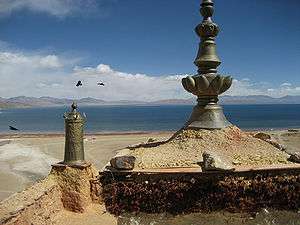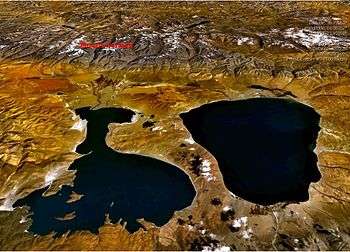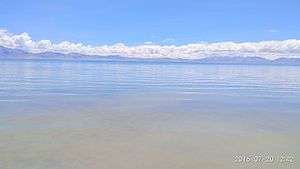Lake Manasarovar
| Manasarovar Mapham Yumtso 瑪旁雍錯 | |
|---|---|
 July 2006 | |
| Location | Tibet |
| Coordinates | 30°39′N 81°27′E / 30.65°N 81.45°ECoordinates: 30°39′N 81°27′E / 30.65°N 81.45°E |
| Surface area | 410 km2 (160 sq mi) |
| Max. depth | 90 m (300 ft) |
| Surface elevation | 4,590 m (15,060 ft) |
| Frozen | Winter |
Lake Manasarovar (also Manas Sarovar, Mapam Yumtso; Tibetan: མ་ཕམ་གཡུ་མཚོ།, Wylie: ma pham g.yu mtsho ; Chinese: 玛旁雍錯 (simplified), Chinese: 瑪旁雍錯 (traditional)) is a freshwater lake in the Tibetan Autonomous Region of China, near Mount Kailash. The lake is revered a sacred place in four religions: Bön, Buddhism, Hinduism and Jainism.
According to legend, Lake Manasasarovara is the lake in which a great Tibetan monk saw the letters "Aha", " Kha", " Mha". These three initials helped the search team to locate the current the 14th Dalai Lama of Tibet. The three initials stand for the province, the district, and the monastery in which the current Dalai Lama was born, i.e. Ahamdho, Khunbum, and Taktser respectively.
Geography

Lake Manasasarovar lies at 4,590 m (15,060 ft) above mean sea level, a relatively high elevation for a large freshwater lake on the mostly saline lake-studded Tibetan Plateau.
Lake Manasasarovar[1] is relatively round in shape with the circumference of 88 km (54.7 mi). Its depth reaches a maximum depth of 90 m (300 ft) and its surface area is 320 km2 (123.6 sq mi). It is connected to nearby Lake Rakshastal by the natural Ganga Chhu channel. Lake Manasasarovar is near the source of the Sutlej, which is the easternmost large tributary of the Sindhu. Nearby are the sources of the Brahmaputra River, the Indus River, and the Ghaghara, an important tributary of the Ganges.
Lake Manasasarovar overflows into Lake Rakshastal which is a salt-water endorheic lake. These lakes used to be part of the Sutlej basin and were separated due to tectonic activity.
Etymology
The word "Manasasarovar" originates from Sanskrit: मानससरोवर , which is a combination of the words "Manasa" and "Sarovar," with manasa meaning "of the mind" and Sarovar meaning "lake". According to Hinduism, the lake was first created in the mind of the Lord Brahma after which it manifested on Earth.[2]
Religious significance



In Hinduism
In Hinduism, Lake Manasasarovar is a personification of purity, and one who drinks water from the lake will go to the abode of Shiva after death. He is believed to be cleansed of all his sins committed over even a hundred lifetimes.[3]
Like Mount Kailash, Lake Manasasarovar is a place of pilgrimage, attracting religious people from India, Nepal, Tibet and neighboring countries. Bathing in Manasasarovar and drinking its water is believed by Hindus to cleanse all sins.[4] Pilgrimage tours are organized regularly, especially from India, the most famous of which is the yearly "Kailash Manas Sarovar Yatra". Pilgrims come to take ceremonial baths in the waters of the lake.
Lake Manasasarovar has long been viewed by the pilgrims as being nearby to the sources of four great rivers of Asia, namely the Brahmaputra, Ghaghara, Sindhu and Sutlej, thus it is an axial point which has been thronged to by pilgrims for thousands of years. The region was closed to pilgrims from the outside following the Battle of Chamdo; no foreigners were allowed between 1951 and 1980. After the 1980s it has again become a part of the Indian pilgrim trail.[3]
According to the Hinduism, the lake was first created in the mind of Brahma after which it manifested on Earth.[2] Hence it is called "Manasa sarovaram", which is a combination of the Sanskrit words for "mind" and "lake". The lake is also supposed to be the summer abode of the hamsa. Considered to be sacred, the hamsa is an important element in the symbology of the subcontinent, representing wisdom and beauty.[5]
According to Hindu theology, there are five sacred lakes; collectively called Panch-Sarovar; Mansarovar, Bindu Sarovar, Narayan Sarovar, Pampa Sarovar and Pushkar Sarovar.[6] They are also mentioned in Shrimad Bhagavata Purana.[7][8][6]
In the Bon religion
The Bon religion is also associated with the holy place of Zhang Zhung Meri sacred deity. When Tonpa Shenrab, the founder of the Bon religion, visited Tibet for the first time - from Tagzig Wolmo Lungring - he washed in the lake.
In Buddhism
Buddhists associate the lake with the legendary lake Anavatapta (Sanskrit; Pali Anotatta) where Maya is believed to have conceived Buddha. The lake has a few monasteries on its shores, the most notable of which is the ancient Chiu Monastery built on a steep hill, looking as if it has been carved right out of the rock.
The lake is very popular in Buddhist literature and associated with many teachings and stories. Buddha, it is reported, stayed and meditated near this lake on several occasions. Lake Manasasarovar is also the subject of the meditative Tibetan tradition, "The Jewel of Tibet". A modern narration and description of the meditation was made popular by Robert Thurman.[9]
In Jainism
In Jainism, Lake Manasasarovar is associated with the first Tirthankara, Rishabha.
Regional terrain

A larger and higher freshwater lake at 4,941 m (16,211 ft) above sea level and 495 km2 (191 sq mi) in size, Angpa Tso (also known as Chibzhang Co, Migriggyangzham Co, East Chihpuchang Hu), is further east on the Tibetan Plateau at 33°24′N 90°17′E / 33.400°N 90.283°E. The largest freshwater lake of its size (290 km2) over 5,000 m (16,000 ft) elevation is Puma Yumco, also on the Tibetan Plateau.
Further reading


- Allen, Charles (1982) A Mountain in Tibet: The Search for Mount Kailas and the Sources of the Great Rivers of Asia. (London, André Deutsch).
- Allen, Charles. (1999). The Search for Shangri-La: A Journey into Tibetan History. Little, Brown and Company. Reprint: Abacus, London. 2000. ISBN 0-349-11142-1.
- "A Tibetan Guide for Pilgrimage to Ti-se (Mount Kailas) and mTsho Ma-Pham (Lake Manasarovar)." Toni Huber and Tsepak Rigzin. In: Sacred Spaces and Powerful Places In Tibetan Culture: A Collection of Essays. (1999) Edited by Toni Huber, pp. 125–153. The Library of Tibetan Works and Archives, Dharamsala, H.P., India. ISBN 81-86470-22-0.
- Lake Manasasarovar is mentioned in the Guru Granth Sahib, the sacred book of Sikhism
- Thubron, Colin. (2010) 'To a Mountain in Tibet'. Harper Collins. ISBN 978-0-06-176826-2
References
- ↑ Nepal Tourism Package
- 1 2 Charles Allen. (1999). The Search for Shangri-la: A Journey into Tibetan History, p. 10. Little, Brown and Company. Reprint: Abacus, London. 2000. ISBN 0-349-11142-1.
- 1 2 In Search of Myths & Heroes By Michael Wood
- ↑ Kailash Yatra. "About Holy Manasarovar Lake - Kailash Yatra". www.kailash-yatra.org. Retrieved 2016-04-25.
- ↑ Eckard Schleberger, Die Indische Götterwelt. Eugen Diederich Verlag. 1997 (in German)
- 1 2 Encyclopaedia of tourism resources in India, Volume 2 By Manohar Sajnani
- ↑ "Narayan Sarovar Temple in Kutch ~ KACHCHH GUIDE". Kutchguide.blogspot.com. 2010-12-19. Retrieved 2015-07-27.
- ↑ "Kutch Visiting Places and Tourist Attraction : Kutch Guide - Gujarat". Gujaratguideonline.com. Retrieved 2015-07-27.
- ↑ The Jewel Tree of Tibet - Robert Thurman. Soundstrue.com. Retrieved on 2013-07-18.
External links
| Wikimedia Commons has media related to Lake Manasarovar. |
| Wikivoyage has a travel guide for Mount_Kailash. |